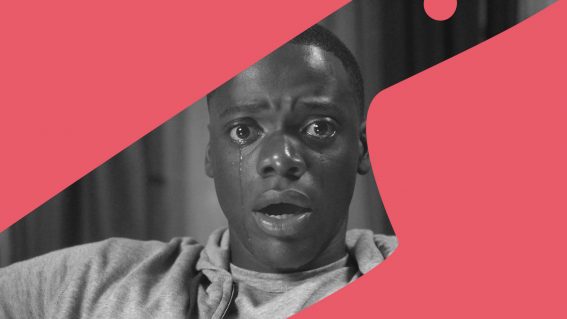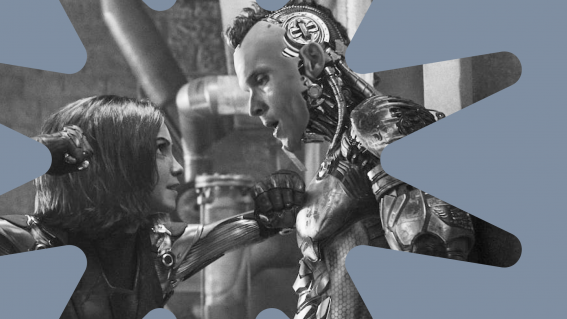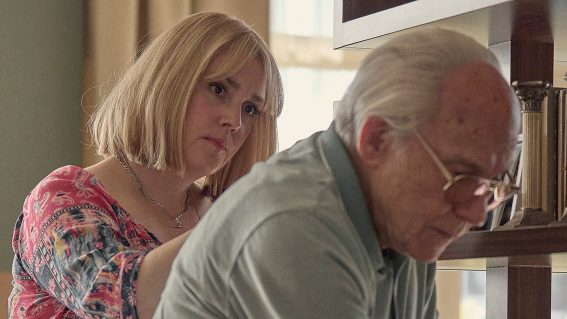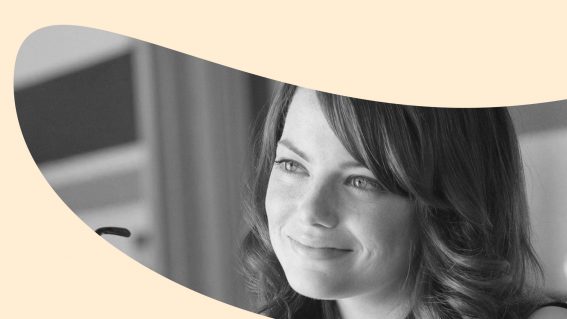Flux Gourmet and the strange and wonderful cinematic world of Peter Strickland
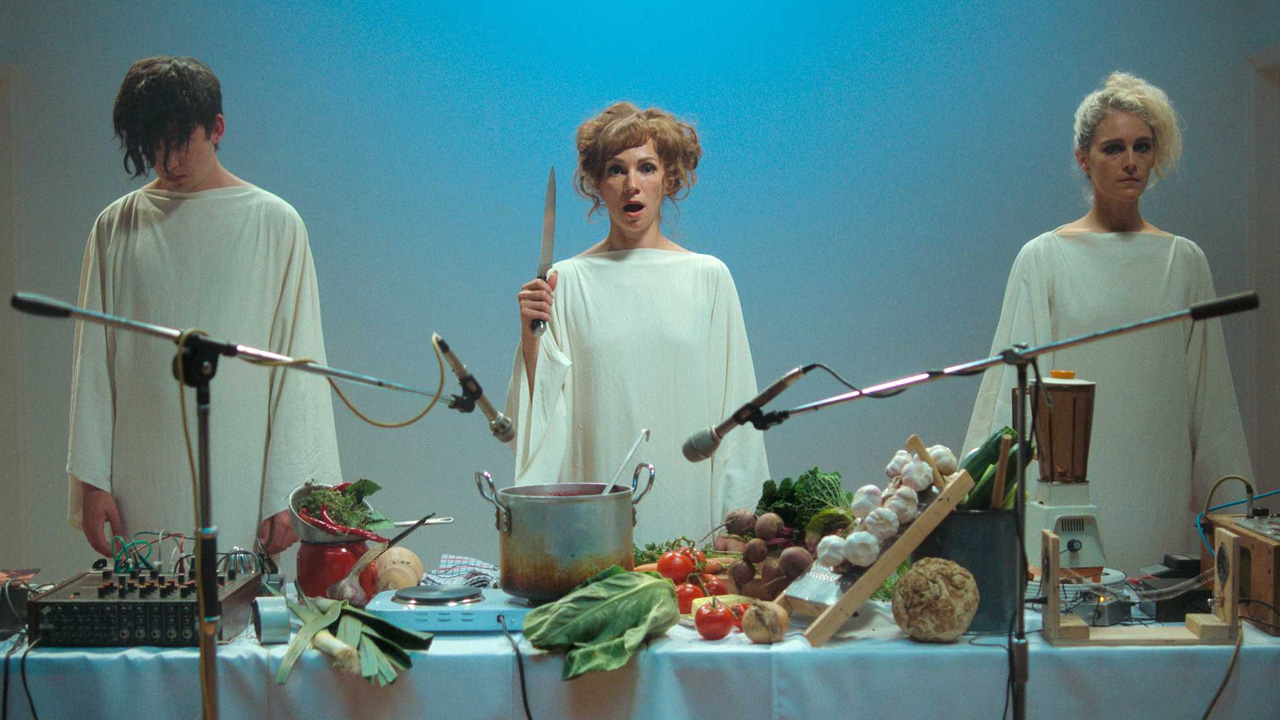
Returning to cinemas after impressing at film festivals this year, Flux Gourmet follows a trio of performance artists through their residency at the Sonic Catering Institute. Surreal, funny and stylish, it’s one of the weirder films of the year – something that’s been true of director Peter Strickland’s prior films. Amelia Berry explores Strickland’s strange cinematic world.
Flux Gourmet
So many of 2022’s best-loved films feel like they’re looking to finally take down superhero cinema on its own turf. Everything Everywhere All At Once, Nope, and even festival fare like Neptune Frost have been taking on high-concept spectacle, pushing into the soft-sci-fi heroic fantasy of film’s most dominant genre.
But while the struggle for the soul of the Hollywood blockbuster goes on (and on), writer/director Peter Strickland’s latest film Flux Gourmet feels like it’s been delivered from a whole other world. A world where the polyester and stale cigarette smoke smell of the 1970s lingers strong into the present. A bizarro parallel present where Giallo never died and nobody thinks the Suspiria remake is better than the original.
If this is your first time entering Strickland’s strange cinematic world, then welcome. It only gets weirder from here.
Flux Gourmet is the story of a trio of performance artists (played by Asa Butterfield, Ariane Labed, and Strickland regular Fatma Mohamed) whose residency at the Sonic Catering Institute is undermined by their dysfunctional relationships with each other, and with the institute’s ostentatious and controlling director, Jan Stephens (Gwendoline Christie). It’s also the story of Stones (Makis Papadimitriou), the writer assigned with documenting their residency, who is plagued with gastrointestinal distress.
Even from this briefest of descriptions, it’s pretty clear that Flux Gourmet is an odd film. Set it an uncanny version of the present, the world of Flux Gourmet is one where making sound art via food preparation is a recognised category of art, where an orgy is the polite response to a successful musical performance, and one where it’s totally normal to dress in flamboyant mid-century editorial avant-chic. It’s a strange little self-contained world of perversion, passion, and bodily preoccupation, set off by a visual style that draws from 1970s British and Italian horror to really hone in on the uncomfortable and the surreal.
While it is a dark, insular, and at times pretty gross movie, Flux Gourmet also serves as a fantastic introduction to Peter Strickland’s filmography. It helps that it’s his most downright funny film to date and has excellent performances by recognisable stars Gwendoline Christie and Asa Butterfield, but Flux Gourmet is also a kind of perfect storm of Strickland’s ongoing fascinations: sound and how it’s made, the strange allure of beautiful clothing, sex and control, gastrointestinal agony. This potpourri of weird preoccupations is the story of Peter Strickland’s career.
With Strickland himself a member of the real-life Sonic Catering Band long before his first feature, it’s no surprise that sound should feature so heavily in his work. 2012’s Berberian Sound Studio is a psychological horror about emotional isolation and sound design, featuring Toby Jones as an English audio engineer hired to work in Italy on a mysterious film.
As Jones’ character Gilderoy begins to mentally unravel, and the world around him becomes more sinister, Strickland creates an overwhelmingly claustrophobic atmosphere, never letting us see the film Gilderoy is working on, only the way that it is slowly destroying him. Between this and the killer soundtrack by Broadcast, it’s no wonder that Berberian Sound Studio has become the best-known of Strickland’s films. Jones and Strickland would go on to work together on a series of two slice-of-life radio plays, The Len Continuum and The Len Dimension, with Jones as a horrible little actor, being rude to women in the park and receiving a pretty aurally full-on colonoscopy (it all comes back to the gut).
Strickland’s other standout, and the film which probably comes the closest to Flux Gourmet in pure vibe, is 2018’s In Fabric. Like Flux Gourmet, In Fabric exists in a weird space of retro-presentism, something like a British mirror of Anna Biller’s The Love Witch, the endless ’70s of Matt Berry’s hilarious Toast of London, or the filmic equivalent of Broadcast-affiliated Ghost Box Records’ sonic ‘hauntology’ (shoutout Derrida). But where Flux Gourmet leans into the silliness of art-music pretension, even at its funniest moments In Fabric is suffused with a grim unease.
Basically, it’s a movie about an evil dress. It’s a movie about a lonely single mother (played with a masterful awkwardness by Marianne Jean-Baptiste), a listless washing machine repairman (Leo Bill), and the small joys and big miseries of ordinary life. It’s a totally singular piece of art that uses horror and humour to craft a mesmerising fairy tale about death and advertising. In Fabric deserves to be right at the top of your ‘to watch’ list, even if you’ve seen it already. The dress is just that evil.
Strickland’s two other features are his two most grounded and serious films (grounded here being a relative term). His debut, 2009’s Hungarian-language rape revenge tragedy Katalin Varga is beautiful, eerie, and devastating, with a plot pulled straight from an Ibsen play (or an unusually focussed Russian novel). Shot in Romania over 17 days for just £28,000, while Katalin Varga lacks the fantastical elements of Strickland’s later films, it’s equally as disjointed in time, feeling more like a lost ’70s art film than a contemporary of fellow 2009 cultural artifact Black Eyed Peas’ I Gotta Feeling.
Meanwhile, 2014’s The Duke of Burgundy is a gorgeous slow-burning erotic thriller. A film entirely populated by women, it follows a pair of lepidopterists in a BDSM relationship, starting off feeling like an artsy porno à la Walerian Borowczyk, it quickly shifts into a taught relationship drama, equal parts dreamy, sexy, sad, and strange.
Something of Strickland’s brilliance is revealed in these films that is often obscured in his others by their sheer captivating weirdness. It’s not just his quirky characters, his wry dark humour, or the consistently brilliant soundtracks and performances. The vital thread that ties his films together is his attention to the agony and power of day-to-day banality. No matter how bizarre or dire the situation, Strickland’s stories are always driven by boring old grudges, slights, jealousies, aches and pains, discomfort and petty ambition. After all, what’s more absurd than the desires of ordinary people?







